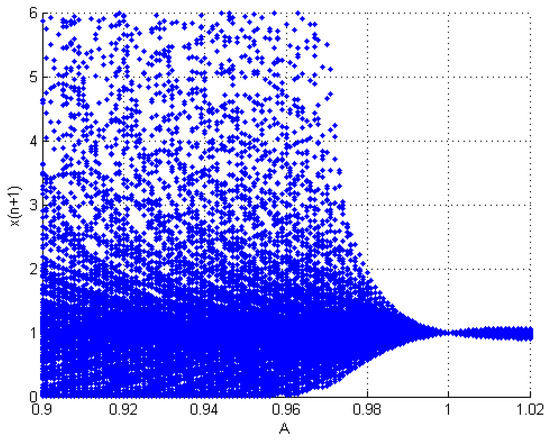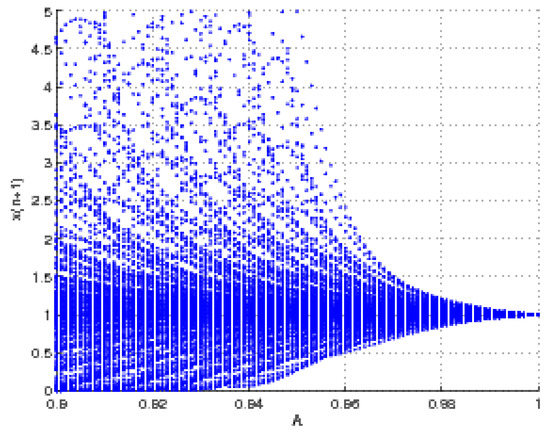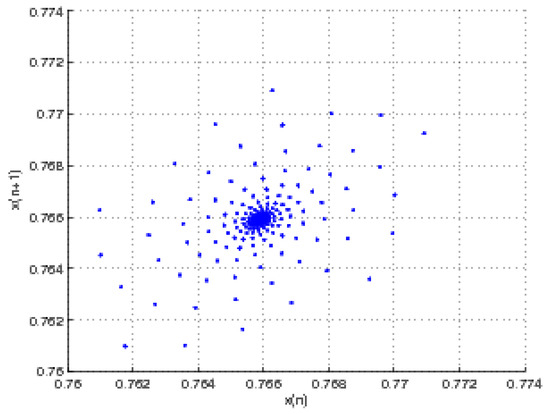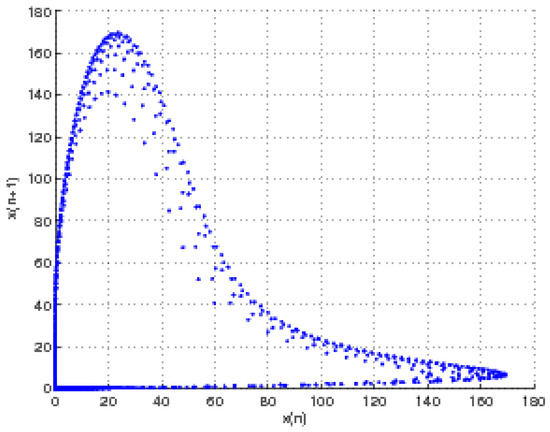Abstract
In this paper, a rational difference equation with positive parameters and non-negative conditions is used to determine the presence and direction of the Neimark–Sacker bifurcation. The neimark–Sacker bifurcation of the system is first studied using the characteristic equation. In addition, we study bifurcation invariant curves from the perspective of normal form theory. A computer simulation is used to illustrate the analytical results.
1. Introduction
1.1. Motivation and Literature Review
In many fields, including economics, biology, and physics, difference equations are essential. Therefore, this field of research is attracting an increasing number of researchers. Since rational difference equations are closed forms of nonlinear difference equations, there is a lot of research on their qualitative behavior. Camouzis et al. [1] present an analysis of the local stability of the rational difference equation at its positive equilibrium point.
and p have positive values and the initial conditions are non-negative. In addition, the authors proved that the positive equilibrium point is locally stable if and unstable if , additionally, if , then every positive solution of Equation (1) converges to the positive fixed point.
Zhang and Ding [2] studied the existence and direction of Neimark–Sacker bifurcation of Equation (1). The authors proved that if and if satisfies then Neimark–Sacker bifurcation occurs.
Camouzis [3] examined the global nature of the third order rational difference equation
where the parameters are non-negative and the initial values are non-negative real numbers. Using a suitable modification in the variables,
where . The author focused on examining the boundness of solutions of Equation (3). Along the same lines of research, authors in [4] examined whether the third order difference equation has a Neimark–Sacker bifurcation.
With parameters , (0, ∞) and initial conditions that are non-negative. It has been shown in Camouzis and Ladas [5] that the unique positive equilibrium , is locally asymptotically stable when and unstable when where . The authors in [4] proved the existence of Neimark–Sacker bifurcation for Equation (4) as passes through the critical value .
In [6] Shareef and Aloqeili studied Neimark–Sacker bifurcation of the following rational difference equation
where the parameters and the initial conditions are non-negative.
In [7], the authors studied the global dynamics and bifurcations of the following two quadratic fractional second-order difference equations:
In [8], rusticet et al. investigated the global dynamics and bifurcations of certain second-order rational difference equation with quadratic terms of the following form
Recently, in [9], Kulenovic et al. studied the Neimark–Sacker bifurcation of the following second-order rational difference equation with quadratic terms
Considering the rational difference equation of the fifth order is motivated by the above work
with positive parameters and p and non-negative initial conditions .
Camouzis and Ladas in [1] have conjectured that the difference equation
for some parameters and initial conditions, it has unbounded solutions. This paper will not prove this conjecture. Equation (9) is a special case of in the previous equation. Numerical simulations showed that for the range of parameter in Figure 1, the solution of Equation (9) is unbounded. As a result, there is no parabolic shape near the bifurcation value. As you can see in Equation (1), is based solely on and , but in Equation (9), is dependent on , , and . To prove the existence of the Neimark–Sacker bifurcation, the same steps are used, including demonstrating that a complex conjugate pair of modulus one eigenvalues exists as well as studying the direction of the bifurcation. However, the calculations differ. Similar equations can be studied using the details of the calculations. A positive equilibrium , is formed when for Equation (9). The next section examines the local stability of this equilibrium. We then demonstrate that this equation undergoes Neimark–Sacker bifurcation when p crosses a certain critical value . Next, we study the direction of the bifurcation. Finally, we present some numerical simulations that support our theoretical analysis. As a discrete time population model, difference equations have a long history [10]. In most cases, these equations describe autonomous, discrete-time dynamics and assume that the only temporal change in vital rates is due to population density (thereby leading to nonlinear difference equations). Vital rates, however, are affected by a variety of other mechanisms and circumstances. In addition, the population’s physical and biological environment can fluctuate, either systematically (such as daily, monthly, or seasonal changes) or randomly (such as stochastic weather fluctuations, resource availability, etc.). For more results, we refer to [11,12,13,14,15,16,17,18,19,20,21].

1.2. Structure of the Paper
The structure of this paper will be as follows: In the following section, we will examine the fixed points along with a linearized form of Equation (11) and apply the jury conditions to evaluate the stability of the system. In Theorem 3, we examined the periodic solution of the model (11). In Section 3 we studied the existence and direction of the Neimark–Sacker bifurcation. The theoretical results are numerically verified in Section 4, whereas the conclusion of the paper is given in Section 5.
2. Main Results
Dynamics of
In this section, we study stability and bifurcation analysis rational difference equation of fifth order
with positive and p parameters and non-negative initial condition , finding equilibrium points of (11)
so
So, it contain two fixed points,
When having a unique positive fixed points, let .
Suppose
So its change into
Theorem 1.
Positive fixed point is stable at , and unstable at , where
Proof.
Let
(12) has a Jacobian matrix
The characteristic equation’s Jacobean matrix is
The jury conditions are used to investigate the stability of .
- (1)
- necessary condition.
- (2)
- sufficient condition.
□
Theorem 2.
Polynomial which is in the form of
For stability necessary conditions are:
By forming table sufficient condition for stability is obtained by
Now general form of sufficient condition is, where
For stability the sufficient conditions are given by
Apply the necessary condition
- (i)
- (ii)
Now the necessary conditions are satisfied, we now apply sufficient condition
Now check for sufficient condition
- (i)
- (ii)
- (iii)
Theorem 3.
The difference equation has no solution of period 2.
Proof.
Proof on contrary suppose it is period 2 solution i.e., ……,……where then .
We have
and so we have,
solving (14) and (15) these equation we get
But
so, which implies . Which completes the proof. □
3. Existence of Neimark-Sacker Bifurcation of
In this section, we will look at the Neimark–Sacker bifurcation of (11) which occurs at as p is bifurcation parameter. Note that Equation (11) has no positive prime period two solution. Hence, we focus our attention on Neimark–Sacker bifurcaton
Theorem 4
([13] (Viete formula)). For any general degree n
The polynomial coefficient is related to the signed sum by the Viete formula. The following are the products of its roots
Proof.
Proof suppose that are the roots of (4.1.1) where and by viete theorem by polynomial
where if and , we obtain
Because roots are formed in a unique way, the above change indicates the presence of a complex conjugate pair in the unit circle. Consider and are roots on so
Make a distinction between the real and imaginary portions.
Rewrite the following two equation in the form of
square (30)
square (31)
add (32) and (33) solve
Now consider
Note for where . Next we show that
where
Suppose that and suitable substitution.
Consider
Now
Put and find
Here contradicts, so
We have demonstrated that the system goes through a Neimark–sacker bifurcation. □
Direction of Neimark–Sacker Bifurcation
In this part, we will look at the Neimark–Sacker bifurcation of (11) and we use normal form theory to find it. In [13], the stability of invariant closed curve of bifurcation from positive fix points is investigated. Now we shift fixed point to the origin take
Can be written which as
So
where
and
Let , where and g are eigenvectors to eigenvalues corresponding and solve
taking equations by multiplying the second and third row to the first column
Consider ,
now from Equation (37)
Note the choice of amuse the first equation has a non-zero solution of . The matrix must be singular so
Now the first equation becomes
Also solving
taking equation by multiplying first row to first column
taking equation by multiplying third row to first column
taking equation by multiplying fourth row to first column
taking equation by multiplying fifth row to first column
let from (39) equation
from (42) equation
put in (41) and get
put in (40) and get
Choice of this g satisfy the equation
To normalize of g ana we must , where represents scalar product in
Now consider , where :
The critical corresponding is two-dimensional. Any vector may be decomposed as
where and . We have
In these coordinates, the map (4.26) given from
Previous system which can be written in the form off
where
And scalar multiple in is used. can be almost as by center manifold theorem
so, . The vectors find linear equation
Now t can be show as
peceived into identities
and
We show t using map
Direction of closed curve can be commuted via
Theorem 5.
If , Neimark-Sacker bifurcation at is supercritical and sub-critical and exist a exclusive closed curve that bifurcation is asymptotically stable from fixed points (respectively unstable).
4. Numerical Simulation
In this section, we give numerical examples which support our result in previous section. For sake of simplicity, we take , , and .
Example 1.


Figure 2.
Neimark–Sacker bifurcation of the map =, where and , we can see that chaos shifted to stability at point .
Example 2.


Figure 3.
Phase portraits of the map = , for .
Example 3.
Example 4.


Figure 4.
Phase portraits of the map = , for .
5. Conclusions and Findings
We present some numerical simulations that support our theoretical results about the Neimark–Sacker bifurcation of model (11). We see a bifurcation diagram in Figure 1 in the (A, ) plane. In this figure, , so the critical value of A at which Neimark–Sacker Bifurcation occurs is = , and the initial conditions are . ensures the asymptotic stability of the positive fixed point. In Figure 3, we plot phase portrait by assigning the values , , = 50. Note that, for this value of A, the positive equilibrium point is asymptotically stable. Figure 4 and Figure 5 illustrate phase portraits by assigning values of A near the bifurcation point. In Figure 4, , , = 50 while in Figure 5, , , = . It is noticeable that we move away from the fixed point that the closed invariant curve disappears, which means the curve is subcritical (unstable). By virtue of Theorem 1, supported by Figure 1, the unique positive equilibrium in Figure 3 is unstable whereas in Figure 4, it is stable.

Figure 5.
Phase portraits of the map = for .
Author Contributions
Conceptualization, A.K., I.M. and T.F.I.; methodology, A.K., T.F.I.; software, W.M.O., B.R.A.-S. and A.A.D.; validation, B.R.A.-S. and M.Y.J.; formal analysis, T.F.I.; investigation, A.K., I.M.; resources, W.M.O., B.R.A.-S. and M.Y.J.; data curation, I.M. and T.F.I.; writing—original draft preparation, I.M.; writing—review and editing, A.K. and I.M.; visualization, A.A.D.; supervision, A.K., T.F.I.; project administration, A.K. and T.F.I.; funding acquisition, T.F.I. All authors have read and agreed to the published version of the manuscript.
Funding
King Khalid University, project under grant number RGP.2/47/43/1443.
Data Availability Statement
All the data used are cited within this manuscript.
Acknowledgments
Authors are thankful to anonymous referee for their valuable suggestions. The authors extend their appreciation to the Deanship for Scientific Research at King Khalid University for funding this work through Larg groups (project under grant number RGP.2/47/43/1443.
Conflicts of Interest
Authors declare that they have no conflict of interest.
References
- Camouzis, E.; Chatterjee, E.; Ladas, G. On the dynamics of xn+1 = ∂xn−2 + xn−3/A + xn−3. J. Math. Anal. Appl. 2007, 331, 230–239. [Google Scholar] [CrossRef]
- Zhang, R.; Ding, X. The Neimark-Sacker bifurcation of xn+1 = ∂xn−2 + xn−3/A + xn−3. J. Differ. Equ. Appl. 2009, 15, 775–784. [Google Scholar]
- Camouzis, E. Global analysis of solutions of xn+1 = ∂xn + xn−2/A + Bxn + Cxn−1. J. Math. Anal. Appl. 2005, 316, 616–627. [Google Scholar]
- He, Z.; Qiu, J. Neimark-Sacker bifurcation of a third order rational difference equation. J. Differ. Equ. Appl. 2013, 19, 1513–1522. [Google Scholar] [CrossRef]
- Camouzis, E.; Ladas, G. Dynamics of Third-order Rational Difference Equations with Open Problems and Conjectures. J. Differ. Equ. Appl. 2013, 19, 1513–1522. [Google Scholar]
- Shareef, A.; Aloqeili, M. Neimark-Sacker bifurcation of a fourth order difference equation. Math. Meth. Appl. Sci. 2018, 19, 1–13. [Google Scholar] [CrossRef]
- Kalabušic, S.; Kulenovic, M.R.S.; Mehuljic, M. Global dynamics and bifurcations of two quadratic fractional second-order difference equations. Comput. Anal. Appl. 2016, 21, 132–143. [Google Scholar]
- Hrustic, S.J.; Kulenovic, M.R.S.; Nurkanovic, M. Global dynamics and bifurcations of certain second order rational difference equation with quadratic terms. Qual. Theory Dyn. 2016, 15, 283–307. [Google Scholar]
- Kulenovic, M.R.S.; Moranjkic, S.; Nurkanovic, Z. Naimark-Sacker bifurcation of second order rational difference equation with quadratic terms. J. Nonlinear Sci. Appl. 2017, 10, 3377–3489. [Google Scholar] [CrossRef]
- Valderde, J.C. Simplest normal forms of Hopf Neimark-Sacker Bifurcations. Int. J. Bifurc. Chaos 2003, 13, 1831–1839. [Google Scholar] [CrossRef]
- Cushing, J.M. Difference equations as models of evolutionary population dynamics. J. Bio Dyn. 2019, 13, 103–127. [Google Scholar] [CrossRef]
- Connor, M.K.; Pilav, E. The Neimark-Sacker bifurcation and global stability of perturbation of sigmoid beverton-holt difference equation. Dis. Dyn. Nat. Soc. 2021, 14, 2092709. [Google Scholar]
- Kalabuši, S.; Kulenovi, M.P.S.; Mehulji, M. Global Period-Doubling Bifurcation of Quadratic Fractional Second Order Difference Equation. Dis. Dyn. Nat. Soc. 2014, 13, 10–53. [Google Scholar] [CrossRef]
- Khaliq, A.; Alayachi, H.S.; Zubair, M.; Rohail, M.; Khan, A.Q. On stability analysis of a class of three-dimensional system of exponential difference equations. AIMS Math. 2023, 8, 5016–5035. [Google Scholar] [CrossRef]
- Kuznetsov, Y.A.; Kuznetsov, I.A.; Kuznetsov, Y. Elements of Applied Bifurcation Theory, 3rd ed.; Springer Applied Mathematical Science: New York, NY, USA, 2013; p. 632. [Google Scholar]
- Kocic, V.L.; Ladas, G. Global behaviour on non-linear difference equations of higher order with applications. Klu. Aca. Pub. 1993, 13, 10–53. [Google Scholar]
- Khyat, T.; Kulenovic, M.; Pilav, E. The Naimark-Sacker bifurcation and asymptotic approximation of the invariant curve of a certain difference equation. J. Comp. Anal. Appl. 2017, 19, 15–22. [Google Scholar]
- Hou, C.; Han, L.; Cheng, S. Complete Asymptotic and Bifurcation Analysis for a Difference Equation with Piece-wise Constant Control. Adv. Differ. Equ. 2010, 13, 542073. [Google Scholar]
- Gari-Demirovi, M.; Moranjki, S. Neimark–Sacker Bifurcation and Approximation of the Invariant Curve of Certain Homogeneous Second-Order Fractional Difference Equation. Dis. Dyn. Nat. Soc. 2020, 12, 625–4013. [Google Scholar] [CrossRef]
- Ibrahim, T.F. Bifurcation and periodically semi-cycles for fractional difference equation of fifth order. J. Nonlinear Sci. Appl. 2018, 11, 375–382. [Google Scholar] [CrossRef]
- Stubna, M.D.; Gilmour, R.F. Analysis of a Non-linear Partial Difference Equation and Its Application to Cardiac Dynamics. J. Differ. Equ. Appl. 2010, 12, 1147–1169. [Google Scholar] [CrossRef]
Disclaimer/Publisher’s Note: The statements, opinions and data contained in all publications are solely those of the individual author(s) and contributor(s) and not of MDPI and/or the editor(s). MDPI and/or the editor(s) disclaim responsibility for any injury to people or property resulting from any ideas, methods, instructions or products referred to in the content. |
© 2023 by the authors. Licensee MDPI, Basel, Switzerland. This article is an open access article distributed under the terms and conditions of the Creative Commons Attribution (CC BY) license (https://creativecommons.org/licenses/by/4.0/).